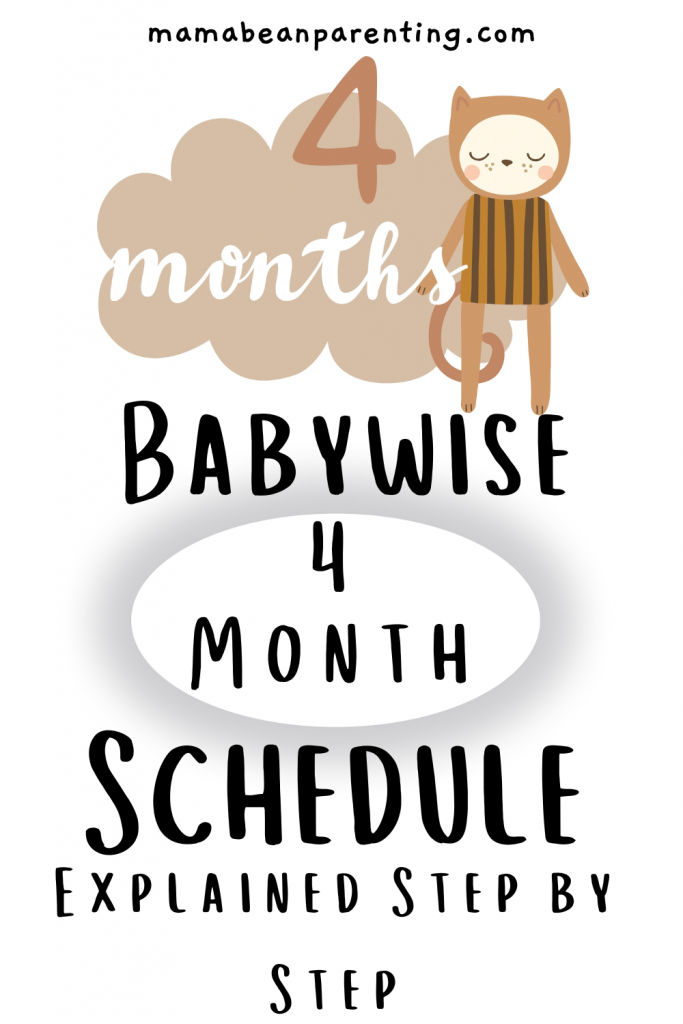You’ve probably heard about the Babywise method.
Who hasn’t?
Maybe you’ve just considered it, or maybe you have already implemented it into your routine. Now, as your baby reaches the 4 month mark, it’s time to transition to a Babywise 4 month schedule.
Keep in mind that it’s never too late to implement the Babywise method. No matter the age, you’re right on time. However, we advise doing your research thoroughly so as to determine whether this scheduling approach is suitable for you and your little baby.
The Babywise method implies a predictable Babywise schedule based on consistency.
But, what does that actually mean? Well, the primary goal of the method is to support your baby’s growth and development by ensuring that your baby follows healthy sleep and feeding patterns while simultaneously helping them reach developmental milestones.
The Babywise 4 month schedule covers a vital developmental period for your baby.
However, it’s equally as crucial to remember that this scheduling technique isn’t going to solve all your problems. It’s not a magical recipe. Stay flexible.
Yes, it’s a perfectly good guide to follow, but you have to take into account that your baby may object to your rules.
Still, many parents swear by its efficiency. While there’s certainly a myriad of different parenting strategies for you to try out, the Babywise guide yet remains a useful and practical tool for parents looking to establish a fixed schedule and routine for their baby.
Bear in mind that every baby is different. So, adapt. Precisely, adapt your parenting strategies to your baby’s needs. Use external resources to refine your own approach.
The Babywise Method Explained

Gary Ezzo and Robert Bucknam created Babywise.
The fundamental idea behind it is the fact that babies prosper with predictability.
Therefore, a well-developed structure leads to fruitful parenting. Babywise covers not only your baby’s sleep and naps, but feeding times and a variety of other daily activities.
Making it all click together and work fluidly takes a lot of trial and error. Still, babies appreciate consistency. By sticking to a consistent schedule, your baby learns to anticipate and predict their daily routine.
By doing so, you help them develop an internal clock.
Babies start to grasp the concept of self-regulation during infanthood. Being responsive and patient teaches self-regulation, but it’s routine that actively stimulates it to develop.
Trusting your baby with a structured schedule opens the doors of growth and development. From a fixed bedtime routine to a scheduled nap, establishing a routine that covers all your baby’s needs makes parenting easy. Still, you have to exercise adaptability.
For example, sticking to a fixed schedule when your baby’s asking for food is a big no. Make sure to respond to your baby’s needs, but stay true to the schedule when you can.
The Babywise approach promotes flexibility. After all, you know your baby best. So, what may work for other parents and babies may not work for you.
You have to stay flexible and adaptive. That means tailoring the schedule in accordance with your baby’s needs.
The Babywise strategy focuses on three main points:
- Sleep
- Feeding
- Awake time
The earlier you start, the better, but it’s never too late, no matter the month.
If you’re just starting with a Babywise 4 month schedule, you can still get all the benefits of establishing a routine based on your baby’s natural rhythm, but it may take more effort if your baby’s not used to it.
In that case, you have to exercise additional patience.
While it’s true that scheduling can impact your baby in a positive way, the Babywise method faces a lot of controversy in regards to its rigidity. As a parent, it’s your primary responsibility to respond to your baby’s needs, even if it means going against schedule.
Structure and routine helps, but you have to stay flexible, too. Find the middle ground and use all the tools, resources and parenting strategies to inspire you to develop your own.
Babywise 4 Month Schedule: Sleep

A four month old baby is becoming more social and acting more deliberately. At this age, your baby is going to need around 14-15 hours of sleep every day, 10-11 of which are at night. Still, the Babywise 4 month schedule also highlights your baby’s need for naps.
During this age, following a sample schedule can help you understand your baby’s needs as you promote healthy sleep patterns. Your baby is learning fast how to communicate, using their cries in different ways to tell you when they’re hungry, frustrated or tired.
Your primary goal should be to establish a set bedtime routine. That way your baby learns how to anticipate when it’s time for bed. Using various calming and relaxing bedtime routines allows your baby to make the connection that it’s time for them to go to sleep.
What kind of relaxing activities can you include? Well, maybe you can read a book to your little one in a low and calming tone.
Bath time also soothes your baby.
You can use essential oils and massage your baby to help put them in a relaxed mood before sleep.
Therefore, you want to avoid over-stimulating your baby before calling it a night.
After you have established a bedtime routine, it’s time to turn your attention to napping. How many naps does your baby need? A four month old baby should take a nap every 2-3 hours. In-between naps, your baby should be awake and active for 1-2 hour intervals.
Your baby’s doing most of their sleeping at night, but throughout the day you need to ensure that they take a total of 2 to 3 naps.
Naturally, a four month old baby is going to need less naps than before, but your baby won’t give up their first nap until 12 months.
At this age, your baby should take their first nap approximately an hour after they wake up, while the last nap of the day should ideally take place 2 to 3 hours before bedtime.
However, even your baby’s nap is supposed to be flexible. A nap is harder to pull off than a bedtime routine, so you might face some difficulty putting your baby down for a nap.
Nap time dynamics vary on a day to day basis, so you have to stay responsive.
But, how flexible should these schedules actually be?
The Babywise schedule offers guidelines for parents, not strict rules that have to be followed at all costs.
As such, you want to make sure that you pay close attention to your baby’s cues and needs so that you can respond responsibly if your baby’s acting up.
The Babywise schedule notes the importance of putting babies to sleep and naps while they’re drowsy but still relatively awake. What that means is that you should time your routines wisely.
A baby that’s still partially awake has to learn to fall asleep on their own.
Doing it this way promotes healthy sleep and individuality in your baby.
You want to stay flexible and adaptive. Babies are unpredictable.
Sometimes they outright fight sleep and routine. Luckily, there’s a wide range of tips and resources that you can use, some of which may even help you learn how to put a baby to sleep in just 40 seconds.
Keep in mind that every baby is different and that all schedules bear different results. Tailor your approach in regards to your baby’s needs and never hesitate to consult a pediatrician if you have any unanswered questions or concerns with your baby’s sleep.
Babywise 4 Month Schedule: Feeding

Aside from sleep routines and schedules, the Babywise parenting guide includes feeding instructions. A four month old baby needs a well-developed feeding plan in order to regulate weight gain and digestion. Take these recommendations with a grain of salt.
Never place priority on routine over your baby’s needs. That implies never disregarding your crying baby. Having a routine is great, but many pediatricians and experts claim that it’s best if you combine your feeding schedule with responsive feeding habits.
The Babywise 4 month schedule details that 4 month old babies should be fed every 3-4 hours. Ideally, your baby should be awake and active for at least 1-2 hours between feeding sessions. Over the course of a day, this adds up to 6-8 feedings per day.
A consistent schedule certainly helps, but there’s no such thing as an all-in-one guide that fits every baby’s needs. All babies have different hunger cues and individual needs. As such, being responsive and feeding on demand is significantly more important.
A 4 month sample schedule or a schedule for any month has its uses, but you have to observe your baby. Crying, rooting and similar reflexes all point to an empty belly.
Some parents exclusively breastfeed, but some incorporate a combination of breastfeeding and pumping, which can be a great alternative once you learn how to make it work.
The outline of the schedule can be adjusted to fit your baby’s needs as necessary.
However, you should aim to feed your baby while they’re up and about, fully awake and alert. Include night feedings as needed. Pay attention to your baby’s weight. Overall, the average weight for a 4 month old baby girl is 14.2 pounds and 15.4 pounds for a baby boy.
The Babywise 4 month schedule includes a general outline for your baby’s sleep habits, feeding times and milestones. Still, it’s important to remember that there are other approaches to parenting and that breastfeeding mothers should feed on demand.
Babywise 4 Month Schedule: Milestones

At this stage of your baby’s development, expect a lot of firsts. From physical and cognitive to social and emotional skills, your little one is breaking new ground. Rest assured that the Babywise 4 month schedule fully supports these developments.
Here’s what you can expect in the coming weeks and months:
1. In the next few months, your baby is going to improve their head and neck movements drastically. Also, expect them to start reaching for items in a desire to play and interact with the world around them as they familiarize themselves with their surroundings.
The Babywise 4 month schedule suggests including tummy time so as to help your baby refine their movements and interact with the world from a completely new perspective.
Naturally, tummy time works to strengthen your baby’s neck and shoulder muscles.
2. A good sample schedule provides many growth opportunities. In the following period, your baby is going to develop extra visual and auditory skills, meaning that they will respond both visually and auditorily not only to your voice, but most of external stimuli.
Routines and habits are becoming more familiar, making it easier for your baby to anticipate when it’s time to sleep and when it’s time for them to take a well-deserved nap.
At this stage, you want to focus on your baby’s cognitive development. Do so by including appropriate activities. Read to your baby. An age-appropriate book boosts your baby’s language skills, communication, stimulates listening, memory and vocabulary skills.
3. Expect advanced social and emotional skills. Your baby’s going to smile more. They may also become more sensitive to isolation and show increased awareness to separation.
During this period, it’s your responsibility as a parent to ensure that your little one gets all the opportunities to refine their social and emotional skills. Practice bonding before bed and when they wake up, too. Also, increase the amount of playtime your baby gets.
All things considered, it’s important that you stay patient. Some babies reach milestones sooner, some later. Respect your baby’s pace and do well to encourage and stimulate their growth. If you have any concerns, don’t hesitate to consult with a pediatrician.
Babywise 4 Month Schedule: Step by Step

Here’s how the Babywise 4 month schedule looks like:
- 7:00 AM: Wake up, followed by feeding.
- 8:30 – 10:00 AM: Time for a nap.
- 10:00 AM: Another feeding session.
- 12:00 – 1:30 PM: Yet another nap.
- 1:30 PM – Feeding session.
- 3:30 – 5:00 PM – Another nap.
- 5:00 PM – Feeding.
- 6:30 PM – Final feeding session and bedtime activities.
- 7:00 PM – Time for sleep.
Now, the idea behind the Babywise 4 month schedule is to provide a stable routine. This routine encompasses your baby’s sleep, naps and feedings. However, there’s room for flexibility. Since every baby is different, you can adjust the schedule as you see fit.
Still, having a general outline as to what you should aim for provides direction.
What about wake times? During wake times, you want to include activities that help your baby grow. You want to provide opportunities that stimulate their brain and drain their energy. These activities vary, so you have a lot of freedom to decide what to focus on.
However, the Babywise 4 month schedule isn’t the only schedule that you can use. You can discover additional information, ideas and suggestions in various sample schedules.
Transitioning into a new day-to-day routine can confuse your 4 month old baby, but there’s no ideal moment when to make that transition. In fact, the ideal time to make that transition is now. The sooner you start being consistent, the sooner you get better results.
Things may take some time until they fall into place. Exercise patience. Don’t expect miracles overnight. Still, we guarantee that by staying consistent and by weathering trial and error that you can fully transition into a new schedule without much difficulty.
However, all transitions have to transpire gradually. You don’t want to shock your baby’s world. Since all babies thrive on predictability, changing things up in a sudden way can upset them. You want to exercise patience as you gently introduce your new schedule.
Navigating the Challenges

Implementing a new schedule poses a big challenge. Prepare adequately. Every baby is their own self. Every single one possesses unique qualities and characteristics that may make sleep schedules seem outright silly. Still, the benefits are there for you to claim.
From bedtime routines to wake times – all of this varies on a case-by-case basis.
Expect it to be difficult in the following months, but expect it to be equally as rewarding.
One of the challenges commonly faced by parents is getting their 4 month old baby to fall asleep. All schedules have predetermined timeframes for sleep and naps – but what happens when your baby outright refuses to sleep and you inevitably miss the mark?
Prepare yourself mentally for your little one to display a rebellious attitude every once in a while. You’re not going to meet every timeframe – it’s impossible. That’s why every timeframe is supposed to resemble a target to aim for, and not a realistic outcome.
However, by establishing a consistent bedtime routine, making sure that you include age-appropriate activities throughout the day, time their feedings and their naps well, you significantly reduce the likelihood of your baby refusing to sleep when it’s time for bed.
Consistency is a pretty word, but real life often makes it impossible to stay consistent for days, never mind weeks and months. Life gets hectic, and you have all these obligations pulling you down. How on earth do parents do it? Well, in reality they likely don’t.
No one’s perfect, and you can’t expect perfection from yourself either. Instead, it’s by staying flexible and responsive that you make it manageable for yourself. Come to terms with the fact that you won’t be able to meet every timeframe, but still do your best.
Since this is a big challenge, communication with your partner is key.
While feeding your baby may seem simple in and of itself, some babies make it difficult for you to stick to your schedule. They either eat too little or too much. They get hungry unpredictably, rendering basically all schedules void. That’s where responsivity comes in.
By feeding your baby on demand and knowing your baby’s hunger cues, you’re still doing a great job. Whenever you can, try to meet the schedule to build routine and habit.
Too many changes at once, too suddenly – and you wind up with a fussy or crying baby. Some babies react better to change, but some have difficulty adapting. Too much over-scheduling can make it difficult for parents to enjoy the journey of parenthood.
Try not to view a sample schedule as an all-inclusive, all-comprehensive guide. After all, the best qualities you can have as a parent are adaptability and flexibility. Staying on schedule all the time is impossible. Being a responsive parent is more than enough.
Dealing With Sleep Regression

In the first few months, newborn babies face little to no difficulty falling asleep. That inevitably helps with maintaining a schedule. However, when your baby turns 4 months, you enter a new period and embrace new problems – one of which is sleep regression.
Suddenly, your baby’s waking up in the middle of the night. Or, your baby’s finding it harder and harder to fall asleep. That sample schedule seemed like a piece of cake, but now there’s a new complexity to it. Luckily, we’re here to provide practical solutions.
Usually, babies experience sleep regression when they reach certain milestones, such as learning to roll over. Science explains that these new breakthroughs are known to disrupt your little one’s sleep. Any new changes in habits and routines further complicate things.
During this headachy chapter of parenthood, you will undoubtedly have more wake time on your hands, more difficulty putting your baby to sleep.
Sleep regression naturally impacts your baby’s napping, too. As such, you will have to make constant adjustments.
The schedule is no longer as fixed as it used to be. Instead, you adjust it as needed. Pay closer attention to your baby’s sleeping habits during this time, because you need to stay responsive.
You need to learn your baby’s cues so as to implement the right changes.
Still, the importance of consistency can’t be overstated. It’s just going to get a bit harder for you to stay consistent. So, make sure to stock up on coffee and positivity.
Remember that sleep regressions don’t last for months, but generally around two to four weeks.
There’s nothing strange or unusual about this period. It’s closely linked to your baby’s development and, as such, something that you would be wise to expect. How you react determines how you deal with it. Include more relaxing activities before bedtime.
Read a book to your baby. Bathe or massage them. These are some of the most common solutions when it comes to lessening the effects of sleep regressions. Stay consistent with your sample schedule, but don’t neglect the importance of soothing activities.
When you have time, read an age-appropriate book to your 4 month old baby in a calm and measured tone, and you will quickly see improvement. Don’t allow frustration to get the better of you. Find your inner strength so as to stay persistent and positive-minded.
Still, if sleep regression turns out to last longer than two or four years, then we advise consulting with a pediatrician in case there are underlying issues to be resolved.
In Conclusion

Using the Babywise 4 month schedule can have many positive effects on your baby’s development and ease the journey of parenthood, but it’s important to do away with rigidity. Instead, use it as a valuable tool to help you create routines and schedules.
Although the Babywise 4 month schedule is specifically designed to help parents establish a fixed and consistent routine, that’s never quite as easy or as simple as it sounds.
Besides, there are many other parenting approaches that you can try out, too.
What works for others may not work for you and vice-versa. That’s why we highlight again the importance of tailoring your own parenting strategy, but staying mindful so as to enrich your skills with various knowledge, tools, resources and even sample schedules.
Every baby is unique and it’s your responsibility as a parent to tackle the challenges you face by staying adaptive and adjusting any schedules you use to meet your baby’s needs.

Mother of three and a primary school teacher. I’ve always loved being around children and helping them, so I chose my path as a teacher. It is sometimes hectic with three children, but I am 100 percent into it and wouldn’t change it for anything in the world.


